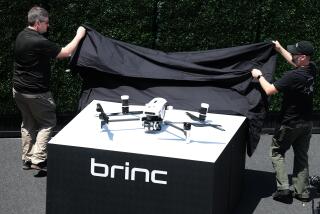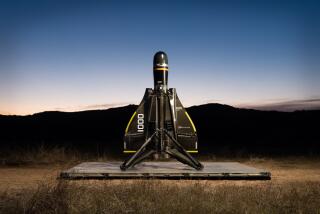Onboard pilot optional with Northrop’s Firebird spy plane
- Share via
Aerospace giant Northrop Grumman Corp. has quietly developed a new spy plane that can listen in on phone conversations, use high-powered radar and shoot live video footage as it flies at 30,000 feet above the Earth.
And the spy plane, expected to be unveiled Monday, would operate with or without a pilot sitting in the cockpit.
Until now, U.S. military aircraft have been designed to either have a pilot on board or be an unmanned drone. But Northrop’s new plane, dubbed the Firebird, can switch from being a traditional aircraft to a drone with just a few modifications.
The Century City company is developing the propeller-powered Firebird at its own expense. It is betting that the hybrid plane will appeal to the Pentagon as defense budget cuts loom and the federal government deals with rising deficits.
“The government is always going to want options with its aircraft,” said Tom Captain, aerospace analyst with Deloitte. “Unmanned aircraft is taking on increasingly difficult missions. However, in the fog of war, there are still situations where you need a pilot’s instinct inside the cockpit.”
If the military has a plane that can do both missions, it may save money on maintenance personnel and spare parts, Captain said. “It’s the same engine. It’s the same airframe. The only difference is how it’s piloted.”
The Firebird would compete for Pentagon contracts with the Predator and Reaper drones that have become ubiquitous in skies over Iraq and Afghanistan. Made by General Atomics Aeronautical Systems Inc. of the San Diego area, Predators and Reapers are often armed with Hellfire missiles or laser-guided bombs as they buzz over the war zone.
Although the Firebird is being touted mainly as an unarmed spy plane, Northrop officials said the Firebird would have the capability to be outfitted with missiles.
Northrop has been testing the aircraft, which resembles a massive dragonfly, at the Mojave Air and Space Port for more than a year as engineers fine-tune the technology.
The Firebird will have a demonstration flight for military brass this month at the Pentagon’s Empire Challenge, a showcase where defense firms demonstrate technologies that can be used in the field in the near term.
Designed to fly for as long as 40 hours at a time with a top speed of about 230 mph, Northrop foresees the Firebird carrying out a variety of reconnaissance and surveillance missions for the military, said Rick Crooks, the company’s program manager.
“Firebird is an adaptable system that makes it highly affordable because of the number of different missions it can accomplish during a single flight,” he said. “It’s a real game changer.”
Crooks also sees the Firebird appealing to law-enforcement organizations for surveillance and government agencies that need spy planes to assess damage after natural disasters.
But the ideal customer is the military. Northrop would like the Firebird to join the military’s growing fleet of robotic spy planes. Defense Secretary Robert M. Gates has said he wants to increase the number of 24-hour drone patrols to 65 a day by 2013 from 39 currently.
Northrop would not reveal how much the Firebird costs. But the company has recently run into problems with the Pentagon over the soaring costs of its higher-flying Global Hawk drone. The robotic jets, which spy at 60,000 feet, cost about $100 million apiece — an increase of 11% since the project started in 2000.
The Firebird was designed, built and tested by Northrop’s Scaled Composites design shop in Mojave. The aircraft was one of the last designs overseen by renowned aerospace engineer Burt Rutan before he retired from the company in April.
More to Read
Inside the business of entertainment
The Wide Shot brings you news, analysis and insights on everything from streaming wars to production — and what it all means for the future.
You may occasionally receive promotional content from the Los Angeles Times.











